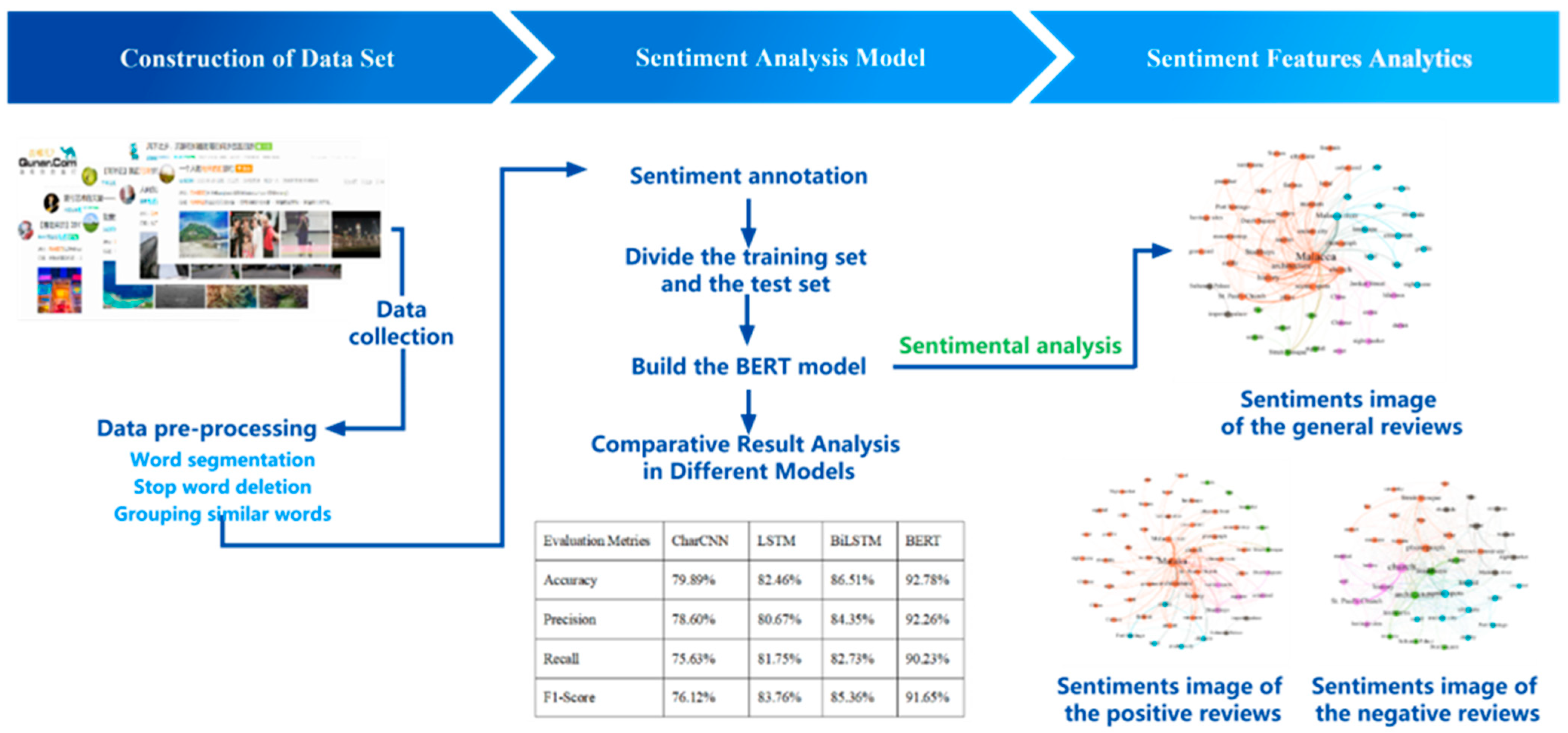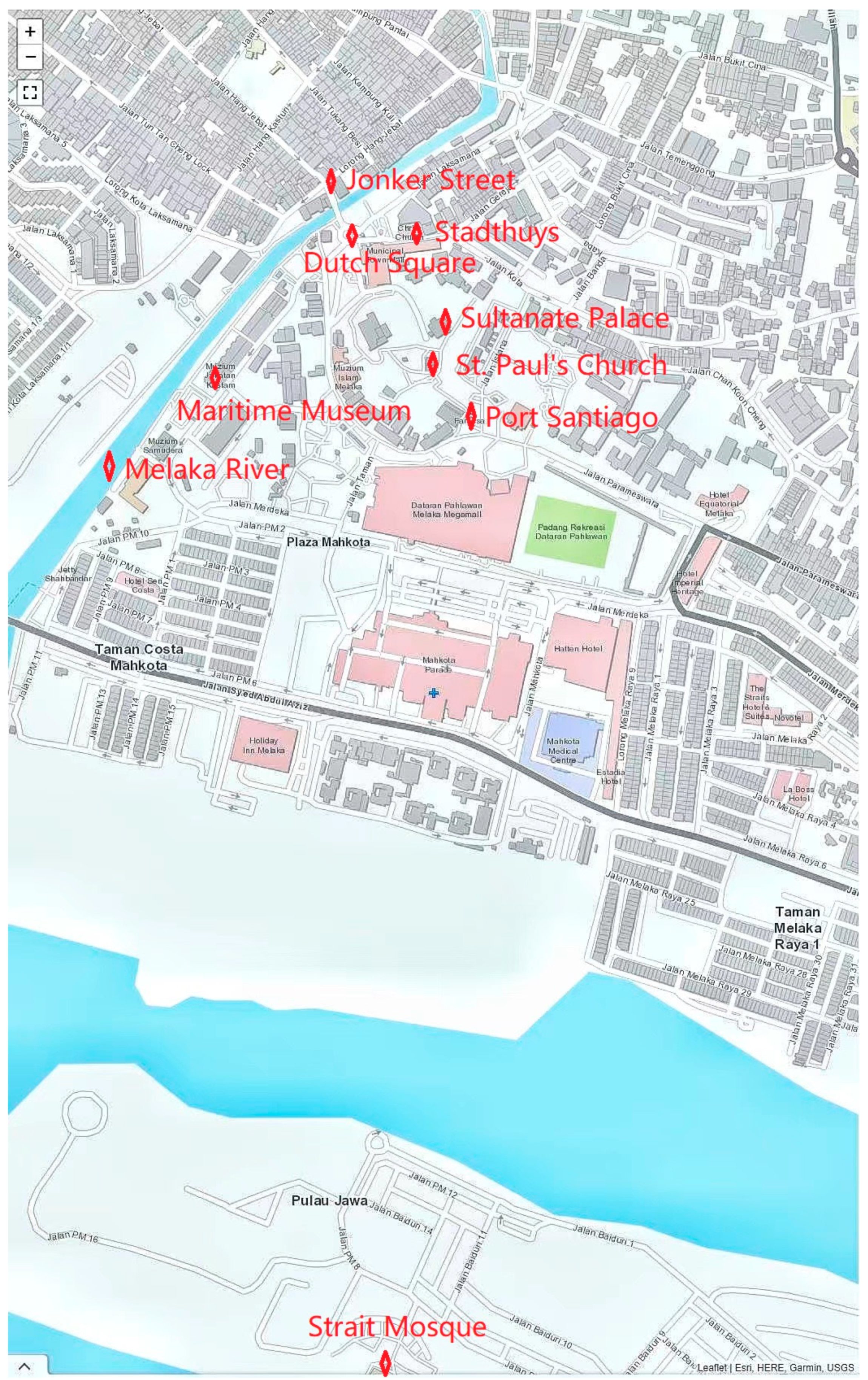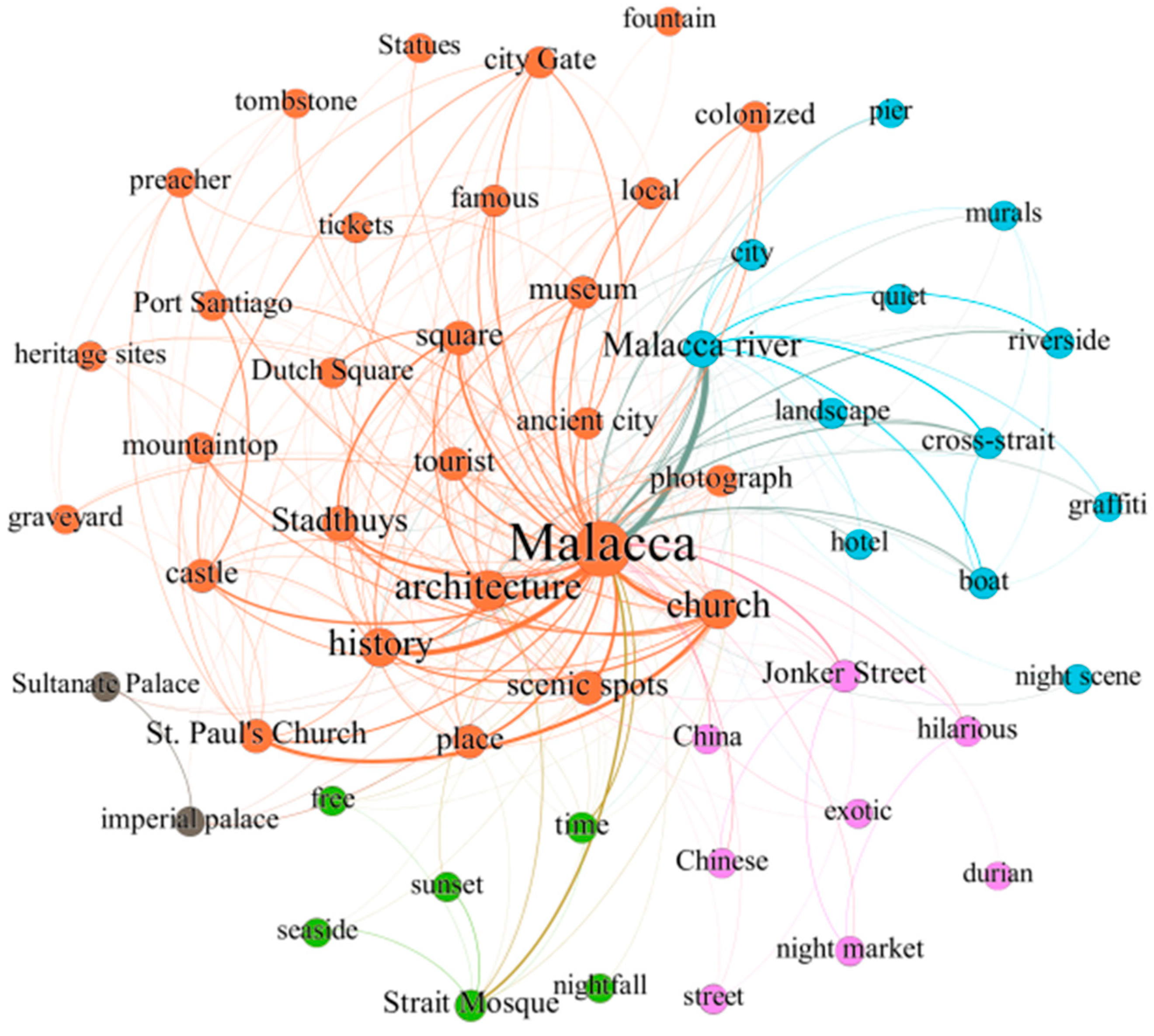Sentiment of Chinese Tourists towards Malaysia Cultural Heritage Based on Online Travel Reviews
Abstract
:1. Introduction
2. Literature Review
2.1. Tourist Perception in Heritage Tourism
2.2. Research on Tourist Sentiment Analysis
2.3. Research on the Advances in Emotion Analysis Techniques
3. Methodology
3.1. Study Area
3.2. Data Collection
3.3. Data Preprocessing
3.4. Sentiment Analysis Model
3.5. Sentiment Feature Analysis
4. Results
4.1. General Sentiment Analysis Results
4.2. Positive and Negative Results
5. Discussion
6. Conclusions and Implications
6.1. Theoretical Implications
6.2. Management Implications
- During the peak tourism season, overcrowding, management confusion, and insufficient staff can occur easily. Heritage sites need to strengthen their management and supervision, such as posting peak hours on the website. This may alleviate overcrowding and visitor expectations. GIS-based mobile apps can help managers analyze visitors’ spatio-temporal activities and predict potential congestion and congestion problems [55]. Destination sustainability could be improved by means of flow control to avoid overtourism [9].
- To strengthen the unique tourism image of the destination, enhance competitiveness, attract tourists, and promote the sustainable development of the destination, first, as a world cultural heritage site, the government and related departments need to deeply explore the architectural culture and intangible cultural heritage, customs, and other cultural resources contained in multicultural integration, and accurately and deeply refine and publicize them. Enhancing Chinese tourists’ experiences and perceptions of Melaka’s unique architectural culture and historical stories will further enhance Chinese tourists’ curiosity and yearning for foreign culture. Second, cultural identity and local attachment are essential factors for tourists’ positive feelings. Through elements such as historical monuments, unique natural landscapes, and colorful folk activities, the cultural and spiritual connotations of heritage sites are fully integrated into tourism programs, enhancing the cultural atmosphere of heritage sites, which helps to stimulate tourists’ cultural identity and local attachment, and strengthen the emotional connection between tourists and the heritage site.
- Cultural performance is an intangible heritage covered by UNESCO’s classifications. Multiculturalism can further enhance the background of Melaka to improve tourists’ understanding of the multi-ethnic lineages that have been assimilated for more than 500 years, such as Baba Nyonya and Chetti [52]. Displaying this unique culture can further enhance heritage activities and experiences by providing local and international tourists with the same experiences. Through the ingenious design of various festivals and entertainment activities, scenic spots can be connected to drive the flow of people through tourist attractions. Local residents can also be integrated into experiential projects that highlight the authenticity of local culture. For example, local residents can volunteer in scenic spots and memorials, or make handicrafts in intangible cultural experience halls. Through emotional exchanges between residents and tourists, tourists can come to deeply understand the local culture, it will improve their enthusiasm and participation, and it can make them ambassadors for the intangible cultural heritage.
- To effectively protect the original cultural ecology of the region and the nation, and to explore the sustainable use of its heritage resources, both to meet the needs of the present generation and to protect the needs of future generations, heritage tourism in Melaka should be explored from a heritage protection perspective. The Melaka Tourism Administration should work closely with relevant conservation agencies to renovate and rebuild dilapidated sites and restore their former glory. To ensure that heritage sites can be restored and maintained, they should be used to generate a sustainable income.
7. Limitation and Future Research
Author Contributions
Funding
Institutional Review Board Statement
Informed Consent Statement
Data Availability Statement
Conflicts of Interest
References
- Rasoolimanesh, S.M.; Seyfi, S.; Hall, C.M.; Hatamifar, P. Understanding memorable tourism experiences and behavioural intentions of heritage tourists. J. Destin. Mark. Manag. 2021, 21, 1. [Google Scholar] [CrossRef]
- Timothy, D.J. Cultural Heritage and Tourism. Muchazondida Mkono 2012, 7, 277–278. [Google Scholar] [CrossRef]
- Szromek, A.R.; Herman, K.; Naramski, M. Sustainable development of industrial heritage tourism–A case study of the Industrial Monuments Route in Poland. Tour. Manag. 2021, 83, 104252. [Google Scholar] [CrossRef]
- Pavli, I.; Puh, B.; Mikovi, L. The perception of travellers and the World Heritage Site image. Tour. Int. Interdiscip. J. 2020, 68, 181–194. [Google Scholar] [CrossRef]
- Tian, M.; Cànoves, G.; Chu, Y.; Font-Garolera, J.; Forga, J.P. Influence of Cultural Background on Visitor Segments Tourist Destination Image: A Case Study of Barcelona and Chinese Tourists. Land 2021, 10, 626. [Google Scholar] [CrossRef]
- Greg, R. Cultural tourism: A review of recent research and trends. J. Hosp. Tour. Manag. 2018, 36, 12–21. [Google Scholar]
- Wu, N. China Tourism Academy President Dai Bin: China’s Outbound Tourism Market Recovery Will Greatly Contribute to the Global Tourism Recovery Process. 11 January 2023. Available online: https://news.bjd.com.cn/2023/01/11/10297412.shtml (accessed on 12 January 2023).
- Batrinca, B.; Treleaven, P.C. Social media analytics: A survey of techniques, tools and platforms. Ai Soc. 2015, 30, 89–116. [Google Scholar] [CrossRef]
- Borrajo-Millán, F.; Alonso-Almeida, M.; Escat-Cortes, M.; Liu, Y. Sentiment Analysis to Measure Quality and Build Sustainability in Tourism Destinations. Sustainability 2021, 13, 6015. [Google Scholar] [CrossRef]
- Ankit; Saleena, N. An Ensemble Classification System for Twitter Sentiment Analysis. Procedia Comput. Sci. 2018, 132, 937–946. [Google Scholar] [CrossRef]
- Jianguo, L.; Xingling, H.; Mengyu, J. Tourist Perception: Review and Outlook of domestic and foreign literature. Econ. Geogr. 2017, 37, 9. [Google Scholar]
- Carnicelli-Filho, S.; Schwartz, G.M.; Tahara, A.K. Fear and adventure tourism in Brazil. Tour. Manag. 2010, 31, 953–956. [Google Scholar] [CrossRef]
- Medina-Viruel, M.J.; López-Guzmán, T.; Gálvez, J.C.P.; Jara-Alba, C. Emotional perception and tourist satisfaction in world heritage cities: The Renaissance monumental site of úbeda and baeza, Spain. J. Outdoor Recreat. Tour. 2019, 27, 100226. [Google Scholar] [CrossRef]
- Vong, F. Relationships among perception of heritage management, satisfaction and destination cultural image. J. Tour. Cult. Chang. 2013, 11, 287–301. [Google Scholar] [CrossRef]
- Tian, C.; Pei, Z. Research on the Relationship between Perceived value, Satisfaction and Loyalty of Tourists in Cultural Heritage Sites–Based on the Empirical Analysis of the Beijing Old Summer Palace. Resour. Environ. Arid Areas 2021, 35, 203–208. [Google Scholar]
- Piuchan, M.; Chi, W.C.; Kaale, J. Economic and socio-cultural impacts of Mainland Chinese tourists on Hong Kong residents. Kasetsart J. Soc. Sci. 2018, 39, 9–14. [Google Scholar] [CrossRef]
- Kim, H.; Stepchenkova, S. Understanding destination personality through visitors’ experience: A cross-cultural perspective. J. Destin. Mark. Manag. 2016, 6, 416–425. [Google Scholar] [CrossRef]
- Liu, J.; Fang, M.; Ning, Z. Perception of Heritage tourism value of tourists and its promotion strategy—Content Analysis Based on Network Information. Geogr. Geogr. Inf. Sci. 2017, 33, 6. [Google Scholar]
- Bai, D. Research on tourist perception evaluation of World Heritage sites based on grounded theory—Take the Terracotta Warriors and Horses of Qin Shihuang as an example. Resour. Environ. Arid. Areas 2016, 30, 198–203. [Google Scholar]
- Min, W. Research on Yin Ruins Based on Network Text Analysis. Reg. Res. Dev. 2019, 38, 5. [Google Scholar]
- Fu, Y.; Hao, J.-X.; Li, X.; Hsu, C.H. Predictive Accuracy of Sentiment Analytics for Tourism: A Metalearning Perspective on Chinese Travel News. J. Travel Res. 2019, 58, 666–679. [Google Scholar] [CrossRef]
- Liu, Y.; Huang, K.; Bao, J.; Chen, K. Listen to the voices from home: An analysis of Chinese tourists sentiments T regarding Australian destinations. Tour. Manag. 2018, 71, 337–347. [Google Scholar] [CrossRef]
- Das, S.R.; Chen, M.Y. Yahoo! for Amazon: Sentiment Extraction from Small Talk on the Web. Manag. Sci. 2007, 53, 1375–1388. [Google Scholar] [CrossRef]
- Faullant, R.; Matzler, K.; Mooradian, T.A. Personality, basic emotions, and satisfaction: Primary emotions in the mountaineering experience. Tour. Manag. 2011, 32, 1423–1430. [Google Scholar] [CrossRef]
- Hudson, S.; Roth, M.S.; Madden, T.J.; Hudson, R. The effects of social media on emotions, brand relationship quality, and word of mouth: An empirical study of music festival attendees. Tour. Manag. 2015, 47, 68–76. [Google Scholar] [CrossRef]
- Hosany, S.; Prayag, G. Patterns of tourists’ emotional responses, satisfaction, and intention to recommend. J. Bus. Res. 2013, 66, 730–737. [Google Scholar] [CrossRef]
- Gupta, G.; Gupta, P. Twitter Mining for Sentiment Analysis in Tourism Industry. In Proceedings of the 2019 Third World Conference on Smart Trends in Systems Security and Sustainablity (WorldS4), London, UK, 30–31 July 2019; pp. 302–306. [Google Scholar]
- Windasari, I.P.; Eridani, D. Sentiment analysis on travel destination in Indonesia. In Proceedings of the 2017 4th International Conference on Information Technology, Computer, and Electrical Engineering (ICITACEE), Semarang, Indonesia, 18–19 October 2017; pp. 276–279. [Google Scholar]
- Kim, K.; Park, O.-J.; Yun, S.; Yun, H. What makes tourists feel negatively about tourism destinations? Application of hybrid text mining methodology to smart destination management. Technol. Forecast. Soc. Chang. 2017, 123, 362–369. [Google Scholar] [CrossRef]
- Deraman, N.A.; Buja, A.G.; Samah, K.A.F.A.; Jono, M.N.H.H.; Isa, M.A.M.; Saad, S. A Social Media Mining Using Topic Modeling and Sentiment Analysis on Tourism in Malaysia During Covid19. IOP Conf. Ser. Earth Environ. Sci. 2021, 704, 012020. [Google Scholar] [CrossRef]
- Garner, B.; Thornton, C.; Pawluk, A.L.; Cortez, R.M.; Johnston, W.; Ayala, C. Utilizing text-mining to explore consumer happiness within tourism destinations. Sustainability 2022, 10, 1366–1377. [Google Scholar] [CrossRef]
- Antonio, N.; Correia, M.; Ribeiro, F. Exploring User-Generated Content for Improving Destination Knowledge: The Case of Two World Heritage Cities. Sustainability 2020, 12, 9654. [Google Scholar] [CrossRef]
- Zen, A. Evaluation of tourist reviews on TripAdvisor for the protection of the world heritage sites: Text mining approach. Disiplinlerarasi Akad. Tur. Derg. 2021, 6, 37–46. [Google Scholar]
- Martín, C.A.; Torres, J.M.; Aguilar, R.M.; Diaz, S. Using Deep Learning to Predict Sentiments: Case Study in Tourism. Complexity 2018, 2018, 69–82. [Google Scholar] [CrossRef]
- Huang, B.; Carley, K. Parameterized Convolutional Neural Networks for Aspect Level Sentiment Classification. arXiv 2019, arXiv:1909.06276. [Google Scholar]
- Xu, H.; Zhang, M.; Zeng, J.; Hao, H.; Lin, H.-C.K.; Xiao, M. Use of Latent Dirichlet Allocation and Structural Equation Modeling in Determining the Factors for Continuance Intention of Knowledge Payment Platform. Sustainability 2022, 14, 8992. [Google Scholar] [CrossRef]
- Xu, D.; Tian, Z.; Lai, R.; Kong, X.; Tan, Z.; Shi, W. Deep learning based emotion analysis of microblog texts. Inf. Fusion 2020, 64, 1–11. [Google Scholar] [CrossRef]
- Hao, J.; Wang, R.; Law, R.; Yu, Y. How do Mainland Chinese tourists perceive Hong Kong in turbulence? A deep learning approach to sentiment analytics. Int. J. Tour. Res. 2021, 23, 478–490. [Google Scholar] [CrossRef]
- Li, Y.F.; Cao, H. Prediction for Tourism Flow based on LSTM Neural Network. Procedia Comput. Sci. 2018, 129, 277–283. [Google Scholar] [CrossRef]
- Law, R.; Li, G.; Fong, D.K.C.; Han, X. Tourism demand forecasting: A deep learning approach. Ann. Tour. Res. 2019, 75, 410–423. [Google Scholar] [CrossRef]
- Kun, Z.; Ye, C.; Chunlin, L. Discovering the tourists’ behaviors and perceptions in a tourism destination by analyzing photos’ visual content with a computer deep learning model: The case of Beijing-ScienceDirect. Tour. Manag. 2019, 75, 595–608. [Google Scholar]
- Cao, Z.; Xu, H.; Xian, B.T.S. Chinese Tourists in Malaysia: An Analysis of Spatio–Temporal Behavior Based on Tourism Digital Footprints. IEEE Access 2022, 10, 122047–122060. [Google Scholar] [CrossRef]
- Devlin, J.; Chang, M.W.; Lee, K.; Toutanova, K. BERT: Pre-training of Deep Bidirectional Transformers for Language Understanding. arXiv 2018, arXiv:1810.04805. [Google Scholar]
- Sun, C.; Qiu, X.; Xu, Y.; Huang, X. How to Fine-Tune BERT for Text Classification? In Chinese Computational Linguistics; Springer: Cham, Switzerland, 2019; pp. 194–206. [Google Scholar]
- Chen, X.; Calder, I.; Mak, B. China’s second-child baby boom and fertility tourism: Strategic considerations for Malaysia. J. Destin. Mark. Manag. 2020, 15, 100377. [Google Scholar] [CrossRef]
- Zhou, L. Study on the Structural Evolution of Urban Tourism Flow Network Based on Network Travel Notes--Take Beijing as an example. Geogr. Sci. 2020, 40, 2. [Google Scholar]
- Arokiasamy, A.; Smith, P.; Kijbumrung, T. Conceptualizing Post-COVID-19 Malaysia’s Tourism Recovery: An Auto-Regressive Neural Network Analysis. Emerg. Sci. J. 2021, 5, 119–129. [Google Scholar] [CrossRef]
- Li, Q.; Jin, Z.; Wang, C.; Zeng, D.D. Mining opinion summarizations using convolutional neural networks in Chinese microblogging systems. Knowl.-Based Syst. 2016, 107, 289–300. [Google Scholar] [CrossRef]
- Kirilenko, A.P.; Stepchenkova, S.O.; Kim, H.; Li, X. Automated Sentiment Analysis in Tourism: Comparison of Approaches. J. Travel Res. 2018, 57, 1012–1025. [Google Scholar] [CrossRef]
- Figueres-Esteban, M.; Hughes, P.; van Gulijk, C. Visual analytics for text-based railway incident reports. Saf. Sci. 2016, 89, 72–76. [Google Scholar] [CrossRef]
- Hua, A.K. Malacca as a world tourism centre: Is it sustainable? Geogr. Malays. J. Soc. Space 2015, 11, 75–85. [Google Scholar]
- Hassan, Z.; Jailani, M.; Rahim, F.A. Assessing the Situational Analysis of Heritage Tourism Industry in Melaka. Procedia-Soc. Behav. Sci. 2014, 130, 28–36. [Google Scholar] [CrossRef]
- Moy, L.Y.Y.; Phongpanichanan, C. Does the Status of a UNESCO World Heritage City Make a Destination More Attractive to Mainland Chinese Tourists? A Preliminary Study of Melaka. Procedia-Soc. Behav. Sci. 2014, 144, 280–289. [Google Scholar] [CrossRef]
- Zheng, S.; Sun, M.; Guo, X. Differences in cultural perception of Chinese and foreign tourists based on text mining— Take the World Heritage site as an example. J. Huaqiao Univ. Philos. Soc. Sci. 2022, 1, 14. [Google Scholar]
- Baniya, R.; Dogru-Dastan, H.; Thapa, B. Visitors’ experience at Angkor Wat, Cambodia: Evidence from sentiment and topic analysis. J. Herit. Tour. 2021, 16, 632–645. [Google Scholar] [CrossRef]





| Tourist Attraction | Frequency | Total % |
|---|---|---|
| Stadthuys | 4531 | 25.81% |
| Melaka River | 2707 | 15.42% |
| Jonker Street | 2457 | 14.0% |
| St. Paul’s Church | 1803 | 10.27% |
| Port Santiago | 1615 | 9.19% |
| Dutch Square | 1369 | 7.80% |
| Strait Mosque | 1069 | 6.08% |
| Maritime Museum | 1026 | 5.85% |
| Sultanate Palace | 978 | 5.58% |
| Total | 17,555 | 100% |
| Comments | Label | |
|---|---|---|
| 1 | Very nice place, one side of the river is the remains of the Westerners, including churches, city gates, etc.; the other side of the river is the living area of the people, very sensational. | 1 |
| 2 | Walk by and feel free to look. No tickets! | 2 |
| 3 | Driving in Melaka is really uncomfortable, driving on the left is really not easy to grasp, and the traffic is too chaotic and there are many cars. | 0 |
| Positive (Actual) | Negative (Actual) | |
|---|---|---|
| Positive (predicted) | A | B |
| Negative (predicted) | C | D |
| Label | Training Set | Test Set | Total |
|---|---|---|---|
| positive | 7170 | 1793 | 8963 |
| negative | 2612 | 653 | 3265 |
| neutral | 4262 | 1065 | 5327 |
| Accuracy | Precision | Recall | F1 | |
|---|---|---|---|---|
| BERT-based approach | 92.78% | 92.26% | 90.23% | 91.65% |
| Evaluation Metrics | CharCNN | LSTM | BiLSTM | BERT |
|---|---|---|---|---|
| Accuracy | 79.89% | 82.46% | 86.51% | 92.78% |
| Precision | 78.60% | 80.67% | 84.35% | 92.26% |
| Recall | 75.63% | 81.75% | 82.73% | 90.23% |
| F1-Score | 76.12% | 83.76% | 85.36% | 91.65% |
| NO. | Scenic Spot | Positive Reviews (%) | Negative Reviews (%) |
|---|---|---|---|
| 1 | Stadthuys | 93.92% | 0.38% |
| 2 | Port Santiago | 89.97% | 1.36% |
| 3 | St. Paul’s Church | 89.81% | 0.84% |
| 4 | Jonker Street | 87.95% | 1.99% |
| 5 | Melaka River | 85.79% | 1.52% |
| 6 | Dutch Square | 85.76% | 1.84% |
| 7 | Sultanate Palace | 83.22% | 1.86% |
| 8 | Strait Mosque | 82.30% | 0.98% |
| 9 | Maritime Museum | 67.68% | 3.42% |
| Comments | Number | Percentage |
|---|---|---|
| Architecture | 2355 | 31.25% |
| Heritage site | 1671 | 22.17% |
| History | 882 | 11.70% |
| Landscape | 828 | 10.99% |
| Tourists | 735 | 9.75% |
| Ticket | 396 | 5.25% |
| Scenic spots | 354 | 5.22% |
| Sunset | 315 | 4.17% |
| Total | 7536 | 100% |
Disclaimer/Publisher’s Note: The statements, opinions and data contained in all publications are solely those of the individual author(s) and contributor(s) and not of MDPI and/or the editor(s). MDPI and/or the editor(s) disclaim responsibility for any injury to people or property resulting from any ideas, methods, instructions or products referred to in the content. |
© 2023 by the authors. Licensee MDPI, Basel, Switzerland. This article is an open access article distributed under the terms and conditions of the Creative Commons Attribution (CC BY) license (https://creativecommons.org/licenses/by/4.0/).
Share and Cite
Cao, Z.; Xu, H.; Teo, B.S.-X. Sentiment of Chinese Tourists towards Malaysia Cultural Heritage Based on Online Travel Reviews. Sustainability 2023, 15, 3478. https://doi.org/10.3390/su15043478
Cao Z, Xu H, Teo BS-X. Sentiment of Chinese Tourists towards Malaysia Cultural Heritage Based on Online Travel Reviews. Sustainability. 2023; 15(4):3478. https://doi.org/10.3390/su15043478
Chicago/Turabian StyleCao, Zheng, Heng Xu, and Brian Sheng-Xian Teo. 2023. "Sentiment of Chinese Tourists towards Malaysia Cultural Heritage Based on Online Travel Reviews" Sustainability 15, no. 4: 3478. https://doi.org/10.3390/su15043478
APA StyleCao, Z., Xu, H., & Teo, B. S.-X. (2023). Sentiment of Chinese Tourists towards Malaysia Cultural Heritage Based on Online Travel Reviews. Sustainability, 15(4), 3478. https://doi.org/10.3390/su15043478



_Li.png)



